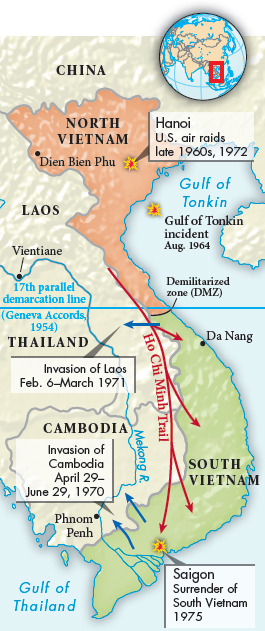The Vietnam War
French Indochina experienced the bitterest struggle for independence in Southeast Asia. With financial backing from the United States, France tried to reimpose imperial rule there after the Communist and nationalist guerrilla leader Ho Chi Minh (1890–
Cold War fears and U.S. commitment to the ideology of containment drove the United States to get involved in Vietnam. President Dwight D. Eisenhower (elected in 1952) refused to sign the Geneva Accords that temporarily divided the country, and provided military aid to help the south resist North Vietnam. Eisenhower’s successor, John F. Kennedy, increased the number of American “military advisers.” In 1964 President Lyndon Johnson greatly expanded America’s role in the Vietnam conflict.

The American strategy was to “escalate” the war sufficiently to break the will of the North Vietnamese and their southern allies without resorting to “overkill,” which might risk war with the entire Communist bloc. South Vietnam received massive military aid. Large numbers of American forces joined in combat. The United States bombed North Vietnam with ever-
Most Americans initially saw the war as part of a legitimate defense against communism, but the combined effect of watching the results of the violent conflict on the nightly television news and experiencing the widening dragnet of a military draft spurred a growing antiwar movement. By 1967 a growing number of critics had denounced the American presence in Vietnam as an intrusion into a complex and distant civil war. The north’s Tet Offensive in January 1968, a major attack on South Vietnamese cities, failed militarily but shook Americans’ confidence in their government’s ability to manage the conflict. Within months President Johnson announced he would not stand for re-
Elected in 1968, President Richard Nixon sought to disengage America gradually from Vietnam. He intensified the continuous bombardment of the enemy while simultaneously pursuing peace talks with the North Vietnamese. He also began a slow process of transferring the burden of the war to the South Vietnamese army, cutting American forces there from 550,000 to 24,000 in four years. Nixon finally reached a peace agreement with North Vietnam in 1973 that allowed the remaining American forces to complete their withdrawal in 1975.
The Vietnamese Communists unified their country in 1975 and began the process of nation building. Millions of Vietnamese civilians faced reprisals for aligning with the United States, including Hmong and Degar peoples (such as the Mnong) and other ethnic minorities. They first fled to refugee camps elsewhere in Southeast Asia and later settled as refugees in the United States. (See “Individuals in Society: Sieng, a Mnong Refugee in an American High School”.)
>QUICK REVIEW
How did the Communist victory in China shape U.S. policy toward Japan and Vietnam?